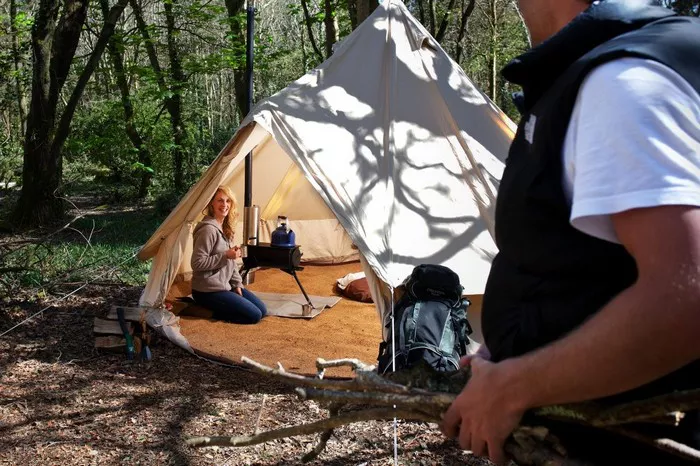It is generally unsafe to use a propane camping stove indoors. This is the primary takeaway that should guide your decision-making when considering the use of such stoves. The risks associated with using a propane stove in an enclosed space far outweigh any potential convenience or benefit. Always prioritize safety by using propane stoves outdoors in well-ventilated areas.
SEE ALSO: What Is the Best Tent for Hot Weather
Is It Safe to Use a Propane Camping Stove Inside?
Carbon Monoxide Poisoning
Propane camping stoves operate by burning propane, a process that releases carbon monoxide (CO) as a byproduct. Carbon monoxide is a colorless, odorless, and tasteless gas that can be deadly when inhaled in significant amounts. In enclosed spaces, such as inside a tent, cabin, or home, carbon monoxide can build up to dangerous levels without you even realizing it. Exposure to high levels of carbon monoxide can lead to symptoms like headaches, dizziness, nausea, and in severe cases, unconsciousness or death. This makes using a propane stove indoors a serious health risk.
Fire Hazards
Another significant danger of using a propane camping stove indoors is the risk of fire. Propane stoves have an open flame, and any nearby flammable materials—such as curtains, paper, or furniture—can easily catch fire if they come into contact with the flame or a hot surface. Additionally, the risk of a propane leak, either from a faulty connection or a damaged fuel line, can result in a gas build-up that could ignite, causing a fire or even an explosion. Indoor environments are not typically equipped to handle such hazards, unlike outdoor spaces where the risk can be more easily managed.
Lack of Ventilation
Enclosed spaces, by their nature, lack the proper ventilation necessary to safely disperse the gases produced by a propane stove. Without adequate airflow, carbon monoxide can accumulate quickly, reaching toxic levels in a matter of minutes. Furthermore, the build-up of propane gas due to a leak or improper use can create an explosive atmosphere. Proper ventilation is critical when using any fuel-burning appliance, and indoor spaces simply do not provide the necessary conditions to ensure safety.
Safety Guidelines
Never Use a Propane Stove Indoors
This cannot be stressed enough: never use a propane camping stove inside any enclosed space, whether it’s a tent, a vehicle, or a home. The risks are simply too great to justify the convenience.
Only Use Propane Stoves Outdoors in Well-Ventilated Areas
Propane stoves are designed for outdoor use, where there is plenty of fresh air to disperse harmful gases. Always use your stove in a well-ventilated area, away from overhanging structures like trees or roofs that could trap gases. Ensure that the area is clear of any flammable materials and that there is sufficient space around the stove to allow for safe operation.
Always Follow Manufacturer Instructions
Manufacturers provide specific safety guidelines and instructions for the use of propane camping stoves. It is crucial to read and adhere to these instructions to ensure that you are using the stove correctly and safely. This includes checking connections for leaks, using the stove on a stable, non-flammable surface, and ensuring that all parts are in good working order before use.
Solutions
Electric Heaters
For indoor heating, consider using electric heaters. These devices are designed for safe indoor use and do not produce harmful gases. Ensure the heater you choose is appropriate for the size of the space you intend to heat and that it has built-in safety features, such as automatic shutoff if tipped over.
Battery-Powered Lanterns
Instead of relying on a propane stove for light, opt for battery-powered lanterns. These are safe for indoor use and can provide sufficient illumination without the risk of fire or carbon monoxide poisoning. Many battery-powered lanterns are also portable and durable, making them ideal for both indoor and outdoor use.
Cooking Methods
When it comes to cooking indoors, there are several safer alternatives to a propane camping stove. Battery-powered grills, electric hot plates, or even microwaves (if power is available) can be used safely indoors. If you have a fireplace, cooking over the fire is another option, provided you have the proper tools and ventilation. For outdoor cooking, a gas-powered grill (used outside only) or a solar-powered oven can offer safe alternatives to propane stoves.
Conclusion
Using a propane camping stove indoors is fraught with danger, from the risk of carbon monoxide poisoning to the potential for fire. The risks far outweigh any perceived benefits, making it imperative to avoid using these stoves in enclosed spaces. Instead, opt for safer alternatives like electric heaters, battery-powered lanterns, and appropriate indoor cooking appliances. By prioritizing safety and choosing the right tools for the environment, you can enjoy your camping or cooking experience without putting yourself or others at risk.

